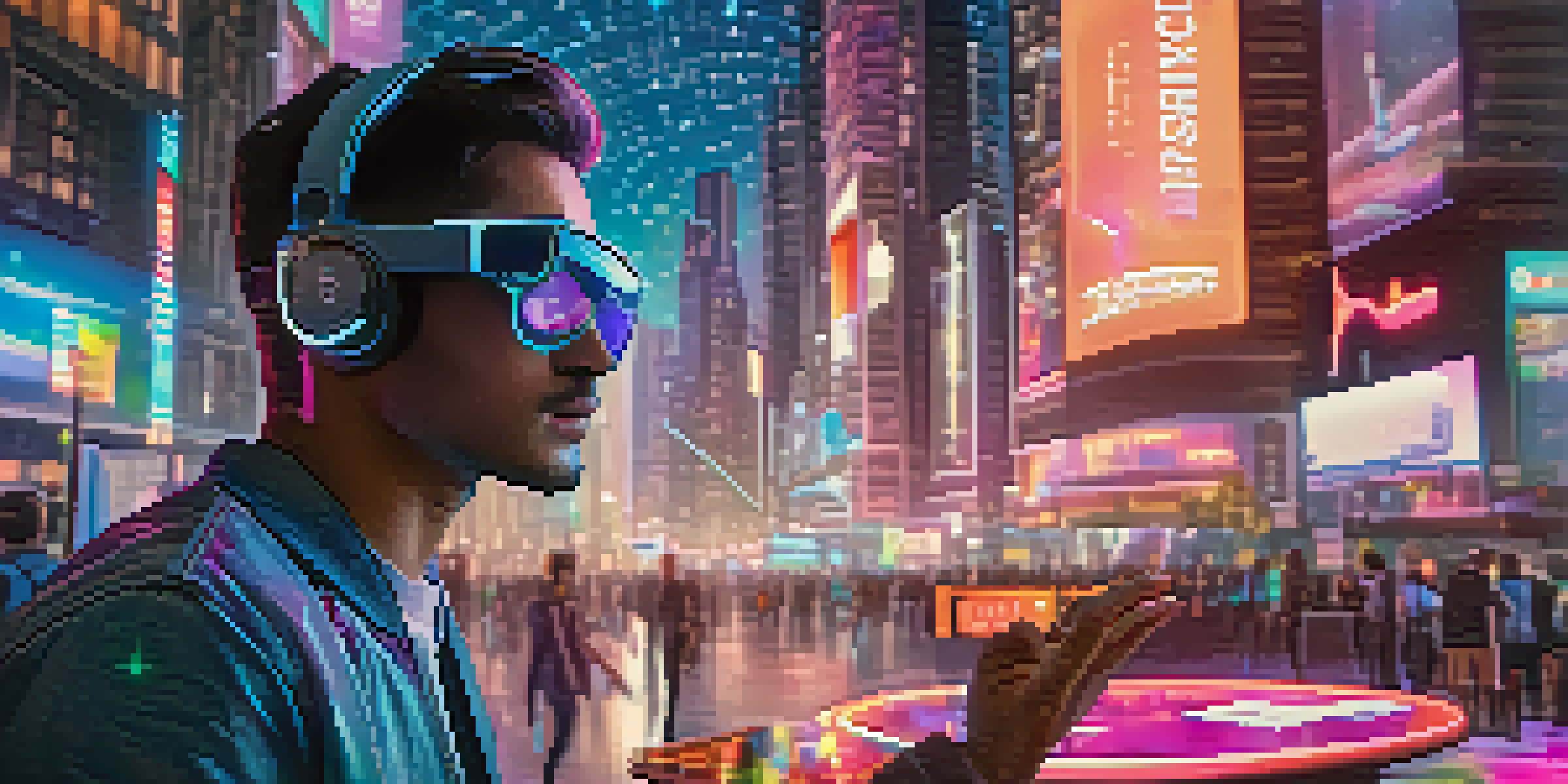Ethereum Smart Contracts: A Game Changer for AR Development

Understanding Ethereum Smart Contracts and Their Functionality
Ethereum smart contracts are self-executing contracts with the terms directly written into code. They run on the Ethereum blockchain, providing a decentralized and transparent way to facilitate agreements without intermediaries. Think of them as digital vending machines: you input a condition, and the machine delivers the product automatically once the condition is met.
Smart contracts are like digital vending machines; they execute automatically when conditions are met, removing the need for intermediaries.
This automation reduces the need for trust and reliance on third parties, as the code ensures that all parties adhere to the agreement. For developers, this means fewer headaches over enforcement and compliance issues. With smart contracts, the process becomes streamlined, ensuring that all actions are recorded and verifiable on the blockchain.
In the context of augmented reality (AR), these smart contracts can handle everything from transactions to user agreements, creating a seamless experience. Imagine being able to access exclusive AR content simply by meeting certain conditions defined in a smart contract. This opens up new avenues for innovation and creativity in AR applications.
The Intersection of AR and Blockchain Technology
The fusion of AR and blockchain is a match made in digital heaven. While AR enhances our perception of reality by overlaying digital information, blockchain provides a secure and immutable record of transactions and interactions. This combination can lead to groundbreaking applications, especially in fields like gaming, education, and marketing.

For instance, consider an AR game where players can earn tokens by completing challenges that are tracked via smart contracts. These tokens can then be exchanged for in-game assets or even real-world rewards. This not only incentivizes player engagement but also ensures that rewards are distributed fairly and transparently.
Smart Contracts Automate Agreements
Ethereum smart contracts streamline transactions by executing agreements automatically, reducing the need for intermediaries.
Moreover, the ability to verify ownership of digital assets using blockchain enhances the overall user experience. Users can buy, sell, or trade AR-enhanced items with confidence, knowing that their transactions are secure and recorded on the blockchain. This creates a vibrant ecosystem where creativity and commerce can thrive.
Enhancing User Experiences Through Smart Contracts
User experience is crucial in AR development, and smart contracts can significantly enhance it. By automating transactions and agreements, developers can create more interactive and engaging experiences for users. For example, an AR app can automatically unlock new features based on user achievements tracked by smart contracts.
The future of augmented reality is intertwined with blockchain technology, creating new dimensions of interaction and trust.
This level of personalization can make users feel more connected to the content, increasing retention rates and encouraging continued engagement. Imagine walking through a museum where your AR app unlocks exclusive content as you interact with exhibits, all facilitated by smart contracts that recognize your participation.
Additionally, the transparency offered by smart contracts builds trust with users. When they know that their actions are being securely recorded and rewarded, they are likely to engage more deeply with the AR experience. In an industry where user trust is paramount, this could be a game changer.
Monetization Opportunities in AR Using Smart Contracts
One of the most exciting aspects of combining Ethereum smart contracts with AR is the potential for new monetization strategies. Developers can create immersive experiences that users are willing to pay for, whether through subscriptions, pay-per-use models, or in-app purchases. Smart contracts can automate these transactions, ensuring that developers receive their due instantly and without hassle.
For instance, a fitness app that uses AR to guide users through workouts can implement a pay-per-session model. Smart contracts would handle the payment processing, unlocking new sessions or features as users complete their purchases. This creates a frictionless experience that encourages users to invest in their fitness journeys.
AR and Blockchain Create New Value
The combination of augmented reality and blockchain technology offers innovative applications, enhancing user engagement and monetization opportunities.
Moreover, with the rise of non-fungible tokens (NFTs), developers can create unique AR assets that users can buy or trade. Smart contracts can facilitate these transactions securely, allowing users to own and showcase their digital collectibles. This not only adds a layer of excitement but also creates a new revenue stream for developers.
Challenges and Considerations in Implementing Smart Contracts
While the benefits of using Ethereum smart contracts in AR development are compelling, there are also challenges to consider. One major concern is the complexity of creating and deploying smart contracts. Developers need a solid understanding of blockchain technology and coding to ensure that their contracts function as intended.
Additionally, the immutability of blockchain can be a double-edged sword. Once a smart contract is deployed, it cannot be easily changed. This means that developers must thoroughly test their contracts before going live, as any errors could lead to significant issues down the line. It's like building a house: you want to get the foundation right before adding the walls.
Finally, scalability is another issue. As more users engage with AR applications that utilize smart contracts, the demand on the Ethereum network can lead to slower transaction times and higher fees. Developers must stay informed about these challenges and consider alternative solutions, such as layer-2 scaling solutions, to ensure a smooth user experience.
Future Trends: The Role of Ethereum in AR Development
As we look to the future, it's clear that Ethereum will play a critical role in the evolution of AR development. With ongoing upgrades aimed at improving scalability and reducing costs, Ethereum's ecosystem is becoming more accessible for developers. This means we can expect to see a surge in innovative AR applications that leverage smart contracts.
Moreover, the rise of decentralized finance (DeFi) can also influence AR development. By integrating DeFi principles, developers can create AR experiences that offer financial incentives, such as staking rewards for engaging with content. This opens up new possibilities for user engagement and monetization, making AR even more enticing.
Challenges in Smart Contract Use
Implementing smart contracts involves complexities such as coding accuracy, immutability risks, and scalability concerns that developers must navigate.
As technology continues to advance, the potential for combining AR and blockchain will only grow. From immersive gaming experiences to educational tools and beyond, the future is bright for those willing to explore the synergy between Ethereum smart contracts and augmented reality.
Conclusion: Embracing the Future of AR with Ethereum Smart Contracts
In conclusion, Ethereum smart contracts are more than just a technological innovation; they represent a paradigm shift in how we approach AR development. By automating processes and enhancing user experiences, they pave the way for exciting new applications and business models. The intersection of these technologies is creating a fertile ground for creativity and growth.
As developers and businesses embrace this change, we can expect to see a wave of AR applications that not only entertain but also empower users. Whether it's facilitating transactions, unlocking content, or creating immersive experiences, smart contracts are set to become a cornerstone of the AR landscape.

The future is here, and it's time to explore the limitless possibilities that Ethereum and AR have to offer. By leveraging the strengths of both technologies, we can create experiences that are not only engaging but also secure and rewarding for users. Let's embrace this exciting journey together.